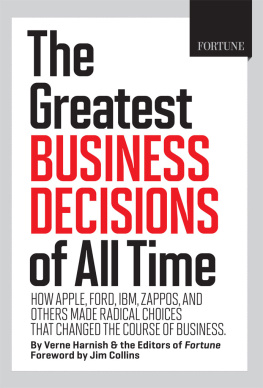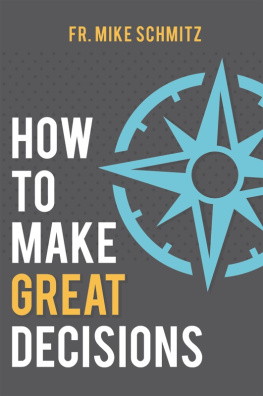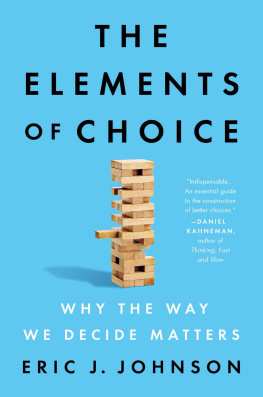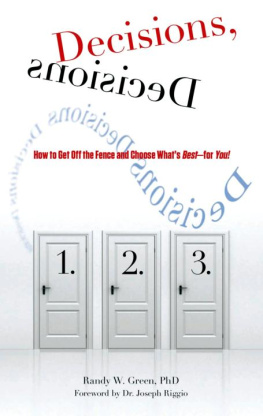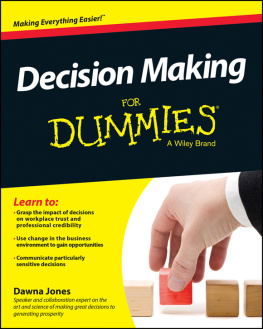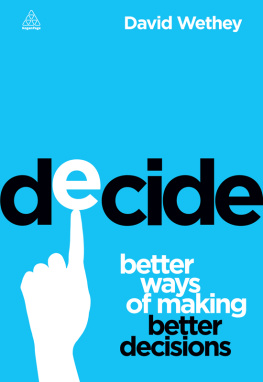The
Greatest
BUSINESS
DECISIONS
of All Time
HOW APPLE, FORD, IBM, ZAPPOS, AND OTHERS MADE RADICAL CHOICES THAT CHANGED THE COURSE OF BUSINESS.
By Verne Harnish and the Editors of Fortune
Foreword by Jim Collins
ACKNOWLEDGMENTS
When you delve into the great decisions chronicled in these pages, youll find that in most instances it was the people involved that really mattered. The same holds true for producing this book. First, we want to thank Fortune managing editor Andy Serwer, who, displaying the vision and entrepreneurial spirit weve long admired him for, green-lighted this project in the same meeting in which we pitched it and then provided support all along the way. Fortune art director Emily Kehe, working with Time Inc.s talented Anne-Michelle Gallero, applied their usual elegant sense of style to the design. Carol Gwinn, our copyeditor par excellence, used her superb language skills to save ourselves from ourselves. Steve Koepp and Joy Butts at Time Home Entertainment Inc., the books publisher, worked creatively behind the scenes to make this project a reality, and for that were truly grateful. And we extend our thanks and admiration to Jim Collins for providing such an insightful foreword to the book. Last, a big bow to the writers and editors on Fortune s staff who used their in-depth knowledge of business and their nonpareil writing skills to make this book what I hope youll find to be a wonderful, informative read.
To
decision-makers
WHO KEEP MAKING THE TOUGH CALLS
TABLE OF
CONTENTS
Introduction
By Verne Harnish
Chapter 1
Apple Brings Back Steve Jobs
By Adam Lashinsky
Chapter 2
How Free Shipping Saved Zappos
By JENNIFER REINGOLD
Chapter 3
Why Samsung Lets Its Stars Goof Off
By Nicholas Varchaver
Chapter 4
At Johnson & Johnson, the Shareholder Comes Last
By Timothy K. Smith
Chapter 5
Why Daydreaming Pays Off Big at 3M
By Geoff Colvin
Chapter 6
How Intel Got Consumers to Love Chips
By David A. Kaplan
Chapter 7
Jacks GE Cathedral
By David A. Kaplan
Chapter 8
Bill Gates Decides to Take a Week Off
By David A. Kaplan
Chapter 9
Softsoaps Blocking Decision
By Brian Oreefe
Chapter 10
Toyota Pursues Zero Defects
By Alex Taylor III
Chapter 11
Extreme Customer Service at Nordstrom
By Geoff Colvin
Chapter 12
Tata Takes the Sting out of a Painful Situation
By Geoff Colvin
Chapter 13
Boeing Bets Big on the 707
By Adam Lashinsky
Chapter 14
IBMs Operation Bear Hug
By Adam Lashinsky
Chapter 15
Wal-Mart Creates the 6 a.m. Meeting
By Hank Gilman
Chapter 16
Eli Whitney: Is Your Business in Trouble? Pivot!
By Geoff Colvin
Chapter 17
The HP Way
By David A. Kaplan
Chapter 18
Henry Ford Doubles Workers Wages
By Alex Taylor III
About the Authors
Geoff Colvin, Hank Gilman, David A. Kaplan, Adam Lashinsky, Brian OKeefe, Jennifer Reingold, Timothy K. Smith, Alex Taylor III, Nicholas Varchaver
By Jim Collins
We tend to think that decisions are very much about what. But when I look at my research notes or at interview transcripts from the executives weve interviewed, one theme that comes through is that their greatest decisions were not what? but who? They were people decisions.
Fundamentally, the world is uncertain. Decisions are about the future and your place in the future when that future is uncertain. So what is the key thing you can do to prepare for that uncertainty? You can have the right people with you.
Lets take a nonbusiness case and a business case to illustrate the importance of the people piece. In 1978, Jim Logan and his partner, Mugs Stump, became the first people to climb the Emperor Face of Mount Robson in the Canadian Rockies. And to this day, nearly everybody else whos tried the face has either died or failed on the route. When I asked Logan, Why were you able to do the Emperor Face? he said, Because I made the single most important decision, I picked the right partner.
He told me that there was this one place, the death zone, and once they went above it, they really couldnt retreat. They were going to either summit or dieno going back. They didnt know what they were going to find beyond that point, and they didnt know what the weather was going to be. And so, therefore, whats your greatest hedge against uncertainty? Having people who can adapt to whatever the mountain throws at you.
In business, lets take the story of a company heading into a very uncertain world: Wells Fargo in the late 1970s. Everybody knows the storm of deregulation is going to hit. But nobody knows precisely how its going to shake out. When is it going to hit? What exact form is it going to take? What impact is it going to have on the banking industry? Dick Cooley, chief executive of Wells Fargo at that time, was very clear with us when we did our research. He said, in essence, I did not know what we were going to have to do to prevail through deregulation, because it was an uncertain set of contingencies. Too many of them. But I did know that if I spent the 1970s building a team of the most capable executives possible, they would figure out what to do when deregulation hit. He couldnt lay down a plan for what was going to happen, because he didnt know what was going to happen. So his decision was actually a bunch of decisions about getting the people who could deal with whatever deregulation turned out to be.
Of course, once you have great people in place, you still have to make decisions. Great decisions begin with really great people and a simple statement: I dont know. The research evidence on that is very clearthat the leaders who ended up setting things in place that produced extraordinary results over time, and a series of great decisions over time, really were very comfortable saying I dont know until they knew.
And really, they were just being honest. I mean, which is best? Lyingmeaning saying you dont know when youve already made up your mind? Or presuming to know when you dont and therefore lying to yourself? Or speaking the truth? Which is: I dont yet know, but I know we have to get it right.
Typically in companies people expect the opposite. They expect their leaders to say clearly, Heres where were headed. The CEO has already made a decision, and his definition of leadership is to get people to participate so that they feel good about the decision hes already made.
Thats wrong, because youre ignoring people who might know a lot that would be useful in making the decision. Youre accepting the idea that because youre in the CEO seat, you somehow know more or youre smarter than everyone else. But what youre really doing is cutting yourself off from hearing options or ideas that might be better.
To create an atmosphere where ideas flow freely, you have to recognize that your position can be a hindrance to getting the best information. And so can your personality. My own greatest enemy is my personalityI can convince the people on my team of a point of view. Im older than they are. Ive done more research than they have. I know more than they do. I can influence them perhaps too much and therefore not get the best answers. So when we were doing the research for Good to Great , I built a culture that began with disagreements, that set people up to disagree with each other and disagree with me.
I tried to increase what I call my questions-to-statements ratio. I learned this from the Good to Great leaders we were studying. They were just marvelous at igniting dialogue and debate with Socratic questions. And I tried to make heroes out of those on my team who identified flaws in my thinking. At the next meeting I might say, I really want to give Leigh or Brian or Stefanie credit. She really pushed my thinking, and I wasnt looking at this right.

